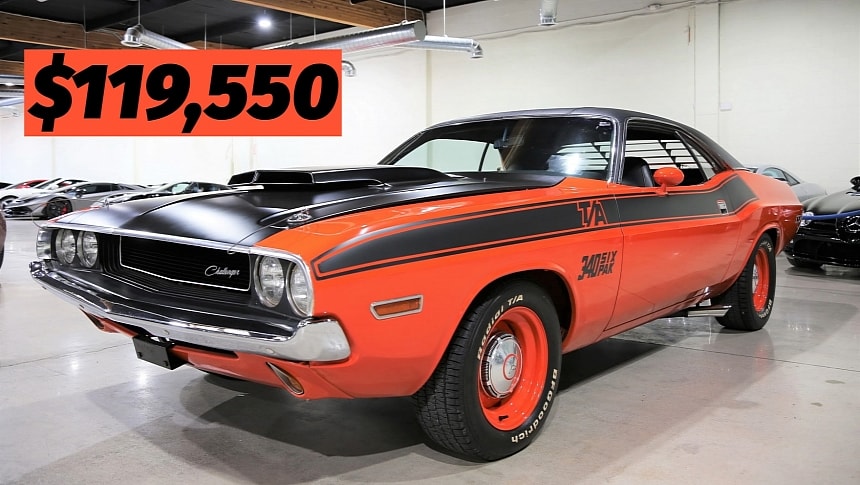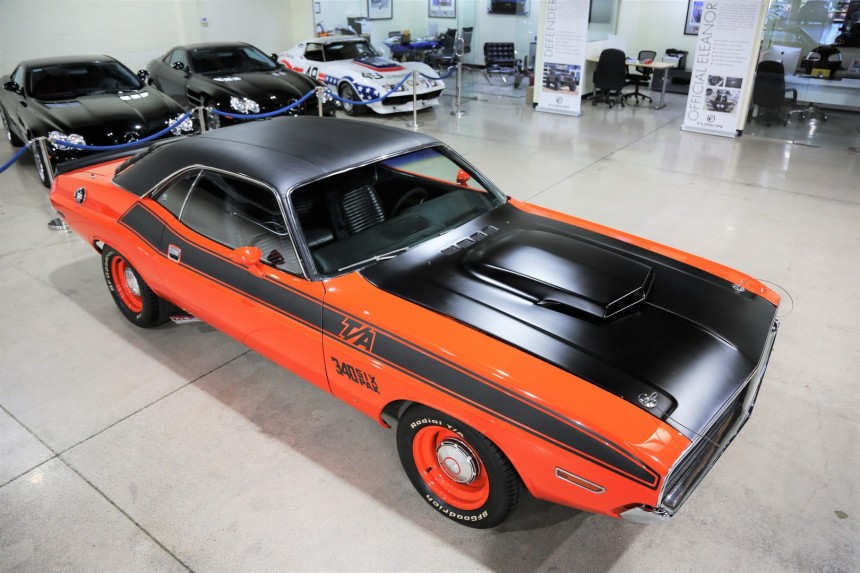If you’re in the market for an early model first-generation Dodge Challenger and money is no issue, then we may have found an absolute gem for you to consider. This 1970 Hemi Orange Challenger T/A 340 Six pack is a rare beast.
Even though the first-generation Dodge Challenger was never quite as capable dynamically as some of its rivals, it more than made up for it with its sheer presence and brute force. For example, choosing between something like a Challenger T/A and a Boss 302 Mustang would have come down to a clash of philosophies.
Thankfully, nowadays we no longer need to explore such dilemmas, because we don’t really compare vintage muscle cars in the same way we did back when they were new. Nowadays, they’re all pretty much bang on perfect.
As far as the first-gen Challenger is concerned, just make sure you’re focusing on an early model year car, preferably either a 1970 or a 1971 example. Not only did those look the best, but you had maximum variety in terms of specs.
Speaking of specs, among the most desirable is the Challenger T/A, or Trans Am, built so Dodge could go racing in the Sports Car Club of the Trans American Sedan Championship. In other words, the Challenger T/A stood as a direct rival to the likes of the Boss 302 Mustang or the Plymouth AAR ‘Cuda. Power came from a 340 ci V8, fitted with three additional two-barrel carburetors on top of the aluminum intake manifold – which is how the 340 Six Pack was born.
These models were factory-rated at 290 horsepower (like a Boss 302), roughly 15 hp more than you got in the original 340 engine.
Other noteworthy highlights included the matte black fiberglass hood with the large air scoop, a low-restriction dual outlet exhaust system, special Rallye suspension with heavy-duty parts, thick side stripes, a fiberglass ducktail spoiler at the rear, and more. Fun fact, the Challenger T/A was one of the first muscle cars in history to feature different size tires at the front and rear.
Now, what you’re looking at here is one of just 2,399 units ever produced by Dodge, rocking an EV2 Hemi Orange exterior over a dark interior with bucket seats. This is a numbers-matching vehicle, where the 340 unit is mated to a period correct 727 automatic gearbox with a Sure Grip Rear End featuring 3.55 gears.
If you want to put this baby in your driveway, it’s going to cost you $119,550, which is considerably more than what you’d pay for a brand-new Challenger SRT Super Stock or an SRT Hellcat Redeye Widebody Jailbreak variant.
According to the ad, this car is “strong running and great looking”, and we can certainly agree with that latter statement. If it truly does run great, then it should make for an amazing purchase.
Thankfully, nowadays we no longer need to explore such dilemmas, because we don’t really compare vintage muscle cars in the same way we did back when they were new. Nowadays, they’re all pretty much bang on perfect.
As far as the first-gen Challenger is concerned, just make sure you’re focusing on an early model year car, preferably either a 1970 or a 1971 example. Not only did those look the best, but you had maximum variety in terms of specs.
Speaking of specs, among the most desirable is the Challenger T/A, or Trans Am, built so Dodge could go racing in the Sports Car Club of the Trans American Sedan Championship. In other words, the Challenger T/A stood as a direct rival to the likes of the Boss 302 Mustang or the Plymouth AAR ‘Cuda. Power came from a 340 ci V8, fitted with three additional two-barrel carburetors on top of the aluminum intake manifold – which is how the 340 Six Pack was born.
These models were factory-rated at 290 horsepower (like a Boss 302), roughly 15 hp more than you got in the original 340 engine.
Other noteworthy highlights included the matte black fiberglass hood with the large air scoop, a low-restriction dual outlet exhaust system, special Rallye suspension with heavy-duty parts, thick side stripes, a fiberglass ducktail spoiler at the rear, and more. Fun fact, the Challenger T/A was one of the first muscle cars in history to feature different size tires at the front and rear.
If you want to put this baby in your driveway, it’s going to cost you $119,550, which is considerably more than what you’d pay for a brand-new Challenger SRT Super Stock or an SRT Hellcat Redeye Widebody Jailbreak variant.
According to the ad, this car is “strong running and great looking”, and we can certainly agree with that latter statement. If it truly does run great, then it should make for an amazing purchase.

























